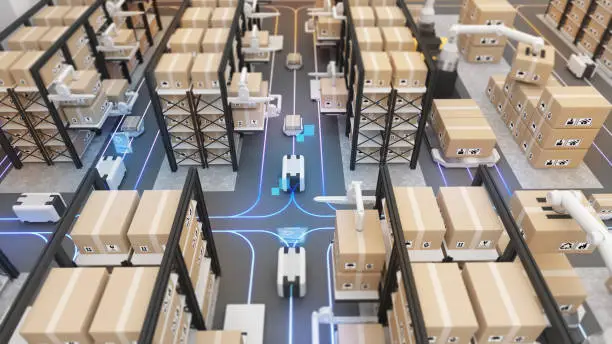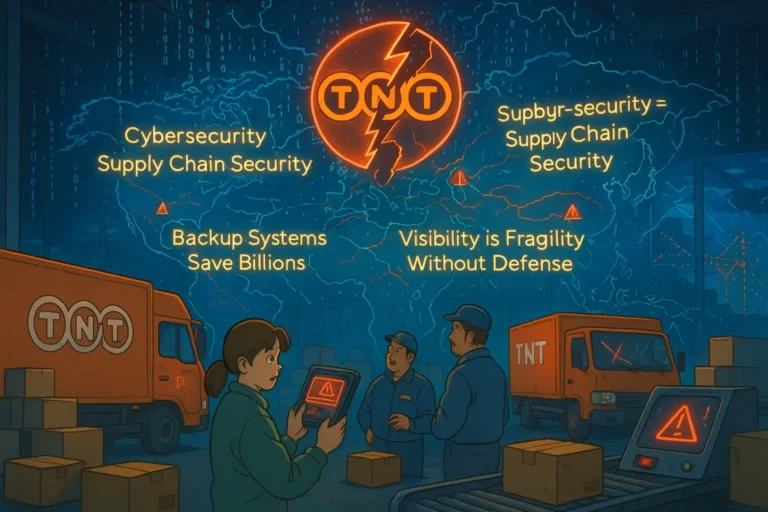
Warehouse automation is becoming a new trend in inventory management, which is not surprising considering how much more the warehouse is optimized.
In this article, we review the warehouse automation guide, including: its importance, types, and how to integrate it.
In the dance for warehouse optimization, automation leads the way.
What is Warehouse Automation?
Warehouse automation is the deployment of technology, such as robotics and software, to carry out operations and tasks in the warehouse instead of relying on people.
These robots can move items around the warehouse, sorting and picking.
On the other hand, software can help process orders and track and monitor the flow of inventory.
With Automation, the warehouse is much more efficient and responsive.
How to Implement Warehouse Automation
Implementing warehouse automation can be complicated but necessary. The steps outlined here will help you simplify it.
1. Analyze the Warehouse Process
To implement automation in your warehouse operations, it is important to start by analyzing the entire process to understand where automation is needed.
When analyzing, the goal is to collect data on warehouse operations and then examine them to find compatibility with automotive technology.
In many cases, the operational processes may have to change to accommodate and rip the benefits of automation.
2. Determine What Kind of Automation Serves You Best
After analyzing your warehouse operations and processes, the next steps are to identify areas that require automation and what kind of automation will suit best.
This is where research on the different automation products takes place. Take surveys or conduct market research to find the best fit for your warehouse.
Identify potential suppliers that can deliver quality automotive products at very good prices and then decide how to engage them and their role in the implementation.
3. Determine the Cost and Potential ROI
Warehouse automation, by all accounts, has a great ROI.
However, it is capital intensive and, in many cases, can be underutilized by warehouses. Especially small scale warehouses with minimal traffic.
Determining the cost of automating your warehouse will help direct your implementation and integration strategies.
You may have to start small depending on available capital and operational capacity. However, bigger warehouses or businesses can go all in.
When implementing, always ensure to calculate the ROI to your warehouse and pinpoint the exact time the investment will mature. This also helps in the utilization and maximization.
4. Integrate SOP For Inventory Control
The purpose of the warehouse is to control, safeguard, and monitor the inventory flow.
To do this effectively, there needs to be a set of procedures or processes that facilitate and ensure this purpose.
However, to install automation in your warehouse, it is important to standardized these procedures using the industry guidelines.
Standard operating procedures are critical for activities like shipping, receiving, sorting, warehouse slotting, and loading inventories.
When SOPs make the installation of warehouse automation easier and more in tune with the warehouse system.
5. Implement, Monitor, and Evaluate
These are the last steps. After ensuring you have the right automation product for your warehouse operation, the next step is to monitor and evaluate its performance.
Before implementing though, it is important to set a schedule. You don’t want to implement the automation at once. You want to do it gradually and incrementally.
Compare processes where automation has been implemented to those yet to be integrated and look for a clear distinction between the two.
Ideally, the automated system should be doing better.
Like most things in the supply chain, automation requires monitoring and evaluating to ensure it meets the purpose or goals of the business.
There should be standard KPIs that will help point to the performance of the automating system.
Why is Warehouse Automation Important?
Automation is critical to optimizing the warehouse and supply chain process. Here are five reasons why you need it.
1. Fewer Errors
Humans are prone to errors. It is not a slight but a fact. However, with robotics and software, those errors can be reduced greatly if not eliminated.
Imagine a warehouse where robots work alongside humans. The productivity is usually off the charts.
Many companies have reported up to 70% fewer errors in their warehouse operations simply by integrating automation.
Automation in the warehouse and supply chain means precise, error-free tasks.
2. Reduces Operational Cost
Warehouse operations are tied to a lot of resources, including humans, machines, energy, and others. With automation, you can streamline and optimize operations, thereby reducing costs.
With automation, you can do more with the same or fewer resources, which helps the business save costs.
Warehouse automation also prevents damages and eros, which tend to cost the business or supply chain a lot of money.
3. Improves Productivity
The productivity of your warehouse is only limited to its available tools and resources.
For instance, a human cannot process multiple orders simultaneously. The human will also find it difficult to operate beyond a certain speed and time.
Robotics and Software solutions, on the other hand, can help out the average human where they are lacking.
They can speed up order processing, which means more orders on any given day and a reduced lead time.
Robotics, on the other hand, can carry out tasks all day without getting tired. Even when it needs maintenance, it takes less time than a human will need to recharge.
4. Ensures Safety
Because your robotics can handle warehouse operations better, it can eliminate accidents and risky errors in the warehouse.
Operations such as lifting, sorting, and handling are accident-prone activities in the warehouse, especially in high-traffic warehouses.
Automation keeps your human workforce safe from heavy lifting and risky operations. A safer environment means motivated and more efficient employees.
5. Customer Satisfaction
The ultimate goal of any supply chain and business process is the customer. It is critical to its survival, and automation is vital in achieving it.
Guaranteeing customer satisfaction can be achieved by automating your warehouse operations.
How can warehouse automation achieve this? By ticking off customer concerns such as reduced order cycle time, real-time tracking, and delivering the right product.
Types of Warehouse Automation
There are many types of warehouse automation. It is an industry with a variety of products, which are, in many cases, offering unique solutions.
Goods-to-Person (GTP)
Picture yourself in a huge warehouse where products are delivered directly to you rather than you having to search for them. That is what GTP entails.
It increases worker productivity by bringing the proper goods immediately to them. Machines like conveyors or robots frequently do the heavy lifting.
Automated Storage and Retrieval Systems (AS/RS)
Picture an enormous vending machine for items when imagining AS/RS.
When you require something, a computer-controlled system collects it from the tall racks where the things are kept.
It moves along quickly and lessens the climbing that human workers must do.
Automated Guided Vehicles (AGVs)
These are akin to warehouse robot assistants. They either use sensors or follow the paths outlined on the floor to move objects around.
They may be seen moving boxes or supplies from one location to another.
Automated Mobile Robots
These are mobile, intelligent robots that are capable of performing a variety of activities.
They resemble robot coworkers in some ways. Some can clean and transport objects, and some can assist staff with inventory checks.
Put to Light and Pick to Light
Pick to Light resembles a treasure hunt in certain ways.
Workers can pick objects more quickly and accurately thanks to lights and displays that point them in the appropriate direction.
Put to Light aids with positioning objects in the proper locations.
Automated Sortation Systems
Have you ever seen those luggage-sorting conveyor belts at the airport? Automated sortation techniques perform in a similar style.
They help swiftly arrange objects according to size, destination, or other criteria.
Voice Picking and Tasking
This is comparable to receiving instructions from a helpful voice in your ear.
Employees are guided through their jobs by a digital voice while wearing headphones. It is hands-free and quite effective.
Categories of Warehouse Automation
There are four different categories or tiers of warehouse automation. In this section of the article, we will explore them.
Basic Warehouse Automation
Having basic warehouse automation is similar to having a helping hand.
Simple technology helps workers carry out actions or activities that were previously more manual.
Think of a conveyor belt that efficiently moves goods or items from one location to another, thereby saving time and energy.
Warehouse System Automation
The automation of the warehouse functions as the brain of the business.
Software, machine learning, and data analytics power it. This intelligent system manages tasks and processes.
For instance, a warehouse management system takes over and organizes orders effectively.
Doing so prevents workers from repeatedly zigzagging across the warehouse and allows them to complete several orders at once.
Mechanized Warehouse Automation
Visualize an automated warehouse as your dependable robotic companion.
Robots and intelligent systems replace people in a variety of warehouse tasks.
Imagine a fleet of autonomous robots picking up full racks of goods and delivering them to employees for retrieval and sorting.
It resembles collaboration between people and machines.
Advanced Warehouse Automation
The warehouse efficiency’s superhero is advanced warehouse automation. Modern automation technologies and mechanized robotics are combined to replace labour-intensive jobs.
Think about a group of robotic forklifts equipped with cutting-edge AI, cameras, and sensors.
These intelligent forklifts easily move throughout the warehouse while relaying their locations to an online tracking gateway in real time.
It’s a symphony of technological operations streamlining.
FAQs on Warehouse Automation
Q1: Is it possible to combine warehouse automation with current systems?
Many warehouse automation solutions work well with current enterprise resource planning (ERP) and WMS software. Automation also makes data flow seamless.
Q2: Are warehouse automation good for the environment?
Warehouse automation may support environmental sustainability by maximizing energy use, avoiding waste, and limiting carbon emissions through effective transportation and inventory management.
Q3: What difficulties do putting warehouse automation into practice present?
High initial expenditures, the requirement for qualified staff to operate and maintain systems, and potential disruptions during the implementation period can all be difficulties. However, the long-term advantages of automation frequently surpass these difficulties.
Conclusion
Warehouse automation is not just a trend; it’s a revolution in inventory management.
In this article, we’ve journeyed through the world of an automated warehouse, exploring its importance, types, and how to implement it successfully.
In the grand dance of warehouse optimization, automation takes the lead.
Automation, powered by technology like robotics and intelligent software, transforms warehouses into efficient, responsive hubs.

Obinabo Tochukwu Tabansi is a supply chain digital writer (Content writer & Ghostwriter) helping professionals and business owners across Africa learn from real-world supply chain wins and setbacks and apply proven strategies to their own operations. He also crafts social content for logistics and supply chain companies, turning their solutions and insights into engaging posts that drive visibility and trust.







